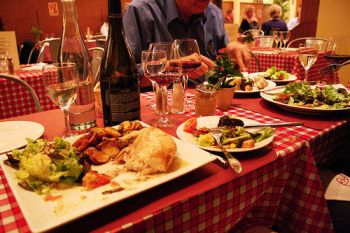 The French take their food seriously. In a land of three hour dinners, afternoons spent at outdoor cafes, hundreds of different kinds of cheese and mandated 35-hour work weeks, the French seem to spend about as much time and energy eating and drinking as they do working.
The French take their food seriously. In a land of three hour dinners, afternoons spent at outdoor cafes, hundreds of different kinds of cheese and mandated 35-hour work weeks, the French seem to spend about as much time and energy eating and drinking as they do working.
However, with a cuisine that has been respected, admired, copied and used as a model for many culinary schools and cuisines around the world, it is no surprise that one of the best parts about visiting France is indulging in all of the great culinary delights. And, while food is certainly a huge part of travel to almost anywhere—France is one of those destinations where many people go JUST for the food.
However, in a country where eating is so much more than simple sustenance, you may find yourself wanting some tips on not only what to eat when you are visiting France, but also how to eat it. Because eating is such a huge part of the cultural experience when traveling in France, those first-time visitors (or returning visitors) may want to brush up on the French joie de manger.
BREAKFAST IN FRANCE
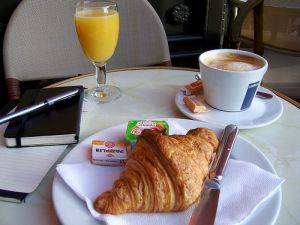 If you start each morning with eggs and bacon or an omelet, it’s not a habit you’ll be able to continue when traveling in France—at least not without inciting some strange and disapproving looks and having a really hard time finding a restaurant that serves these items in the a.m.
If you start each morning with eggs and bacon or an omelet, it’s not a habit you’ll be able to continue when traveling in France—at least not without inciting some strange and disapproving looks and having a really hard time finding a restaurant that serves these items in the a.m.
While I recently read that the American style brunch is starting to become more popular in France, most French generally can’t really imagine eating meat or anything else that savory in the morning.
The French start the day with a light breakfast that’s typically a café au lait, hot chocolate or tea served with toast, a piece of baguette with jam and/or butter or a croissant. For those milk drinkers, be prepared to get some truly confused looks if you ask for a cold glass of milk. This was a part of my American father’s morning routine that he rather unsuccessfully tried to bring with him to France. His request was most often met with blank stares and a “you want what?”
While many hotels will offer a breakfast (and sometimes even an American style breakfast) you are better off skipping it and heading to a café where it will often be much less expensive.
You can also always buy a fresh croissant from a boulangerie or patisserie and take it with you to a café to enjoy with your big boule of café au lait. Some bakeries and cafes will also offer breakfast deals that come with orange juice, a croissant and coffee or tea for around €5-€6.
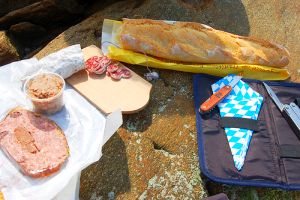
LUNCH IN FRANCE
One of my favorite things to do in France for lunch is buy ingredients from an outdoor food market and picnic. For not a whole lot of money, and a fun shopping experience, you can easily have a high-class picnic for just a handful of Euros.
Stop at a boulangerie and get a baguette before heading to a grocery store or market to stock up on some meats, cheeses and produce. Throw in a decent bottle of wine for a few euros and you’ve got yourself a high class meal. Be daring and don’t be afraid to try those stinky cheeses and ugly pates.
If there is not an outdoor food market where you can gather several items at once—stop by a boulangerie for a baguette, a charcuterie for deli items like meats and pates and an epecerie for drinks and veggies. If you are feeling indulgent (and who doesn’t when they are in France) you can end the meal with a flaky French pastry from a patisserie.
>>Read more about shopping at the Paris Food Markets and Food Shopping in France
 If you aren’t up for doing that much shopping, but still want to picnic, you can also get take-away sandwiches (I like jambon fromage) on baguettes and enjoy them in a park. Bakeries will also often sell quiches, pizzas and a few other selected ready made items for a quick, easy and cheap lunch. If you are looking to save money on lunch for a nice dinner out later in the day, you can also opt for grabbing a Panini or falafel on the streets in Paris or other French cities (get tips for eating on the cheap in Paris).
If you aren’t up for doing that much shopping, but still want to picnic, you can also get take-away sandwiches (I like jambon fromage) on baguettes and enjoy them in a park. Bakeries will also often sell quiches, pizzas and a few other selected ready made items for a quick, easy and cheap lunch. If you are looking to save money on lunch for a nice dinner out later in the day, you can also opt for grabbing a Panini or falafel on the streets in Paris or other French cities (get tips for eating on the cheap in Paris).
French cafes and brasseries can also provide a great, lighter meal in the middle of the day if you want to sit down to eat somewhere for lunch. Unlike at restaurants, many of these brasseries will serve food at any hour—meaning you can lunch at 11 a.m or at 3 p.m. without any problem. You’ll often see price fixed lunch specials (or “formules”) at some restaurants where you can get a really nice meal for not much money.
DINNER IN FRANCE
 If you are lucky enough to get invited into a French person’s home for dinner, don’t be surprised if the dinner party lasts a good 5 hours—and almost all of that time is spent around the table.
If you are lucky enough to get invited into a French person’s home for dinner, don’t be surprised if the dinner party lasts a good 5 hours—and almost all of that time is spent around the table.
When I was living with my great-aunt in Paris, her intricate dinner parties would usually start around 7 with an aperitif (read about French aperitifs) and would end around midnight with coffee or a digestif.
If you head out to a restaurant for dinner, you’ll find that fixed price menus are quite common in France and are typically a really great value. Some restaurants will also have several different fixed price menus to choose from that increase in size, complexity and price. For example, there may be an €16 option where you can choose 1 of 3 appetizers, 1 of 3 entrees and 1 of 3 desserts or a cheese plate. The next option up may be a €22 option with a soup course of varied choices on each course.
When eating out in France, you will often be asked first if you’d like water, either gazeuse (with gas or sparkling water) or without. If you want a simple pitcher of water, just ask for un carafe de l’eau. Also, unlike in the United States, it is usually really affordable to get a bottle of wine to go with dinner. You can get a pitcher, or carafe, of house wine for affordable prices.
It is also rare to find a menu in English in France (and if the menu is in English, you probably want to choose a different restaurant). If you don’t speak much French, you may want to bring a menu decoder. Or, if you are adventurous, you can wing it and see what you end up with.
DRINKING IN FRANCE
Of course, as important as eating in France is also drinking in France. Whether it is alcoholic or not, here is a run-down on the beverages you are likely to run into while in France.
Non-Alcoholic Drinks
If you want tap water, ask for eau nature. Bottled water is often bubbly and is referred to as gazeuse.
Ice cubes are hardly ever found in France. It’s just the way it is.
As discussed in my section about breakfast, milk is really only served with coffee in the morning. Ordering a glass of milk to drink with a meal is not common and will probably illicit some strange looks if you make this request.
Soft drinks tend to be really expensive at cafes in France. In fact, you’ll often save money by opting for wine over a pop. So skipping the sugar and going for the le vin is probably a better way to go.
Coffee (café) is of the espresso nature and is drunk throughout the day, often following a meal. While café au laits and cappuccinos are served at breakfast, it is not common to have coffee served with cream later in the day.
Alcoholic Drinks
 Wine (vin) is drunk with almost every meal in France (except breakfast of course). My grandmother (who often brings wine in water bottles to parks and pools to accompany her lunch) has always said that’s it’s not a really a meal unless you have wine to go with it. Luckily, wine is inexpensive in France. You can order the house wine (vin du maison) in pitchers for your table at restaurants. You can also buy bottles of wine in the grocery store for just a few euros a bottle.
Wine (vin) is drunk with almost every meal in France (except breakfast of course). My grandmother (who often brings wine in water bottles to parks and pools to accompany her lunch) has always said that’s it’s not a really a meal unless you have wine to go with it. Luckily, wine is inexpensive in France. You can order the house wine (vin du maison) in pitchers for your table at restaurants. You can also buy bottles of wine in the grocery store for just a few euros a bottle.
>>Check out the Guide to French wine and learn more about the wine regions of France
Beer is usually consumed as a refreshing mid-afternoon or early evening drink. You will often find it bottled, but it can be found at some bars à la pression (on tap). Beer tends to be rather pricey in France, and the best time to get a deal on beers is usually around happy hour time.
Aperitifs
A light pre-dinner cocktail is common in France (it is believed that help stimulate the appetite). They can be sweet or bitter.
>>Read more about French aperitifs
Cocktails
American style cocktail creations are not all that common in France unless you find yourself in a bar or hotel that caters to an international crowd. You will see some common French cocktails (I always order gin fizzes). While the Sidecar and the Bloody Mary were rumored to have been born at Harry’s Bar in Paris (read more about 10 famous cocktails and where they were born), if you order a martini in Paris you will likely get a glass of Martini and Rossi sweet vermouth.
Digestifs
After dinner drinks that are thought to help with digestion (hence the name) and are often served after larger meals. In contrast to aperitifs, digestifs usually contain a higher alcohol content and are typically drunk neat (straight). Common digestifs are bitters, brandy, whiskey or port.
A FEW TIPS ON TABLE ETIQUETTE AND MANNERS IN FRANCE
 You’ve probably heard rumors about how the French tend to be sticklers about table etiquette in France. While the rules have certainly relaxed in recent generations, the French do tend to hold table manners in higher regard than we do here in the U.S. Growing up with a French grandmother taught me a few of the most important rules about table manners in France.
You’ve probably heard rumors about how the French tend to be sticklers about table etiquette in France. While the rules have certainly relaxed in recent generations, the French do tend to hold table manners in higher regard than we do here in the U.S. Growing up with a French grandmother taught me a few of the most important rules about table manners in France.
- Don’t rush through a meal. No really, just don’t. This is a cardinal sin in France. My grandmother will always quickly quip “la table n’est pas louee” (the table is not rented) when she feels we are rushing through dinner at all. I also once had a waiter hold my bill hostage when I asked him for it before I had finished eating in a Paris brasserie (I explained I was running late, he lectured me on the importance of taking my time when eating).
- Keep your hands on the table. Sure, you may have been brought up to keep your hands gently resting in your lap when at the dinner table, but in France it is polite to keep your hands resting on the table instead.
- Don’t bite into a whole piece of bread. This is considered rather crass and impolite in France. Instead, rip smaller bites off your bread as you go.
- It’s ok to leave your bread on the table. Unless you are at a super formal meal with bread plates, it’s common procedure to leave you bread right on the tablecloth next to your plate.
- Salad is served after the main course in France, not before. I grew up doing it this way in my French-American household, and until I was about 12, I thought everyone else eating their salads BEFORE the main course in the U.S. were strange.
- Don’t eat with your fingers. The French eat almost everything with a fork and knife. Save for tearing into your piece of baguette with your hands, it is really impolite to eat with your hands—even foods us Americans usually think of as finger foods like French fries. I sat and hilariously laughed when my French friend Marion came to visit me in the U.S. and attempted to eat a taco with a fork and knife. It’s just in their blood.
- Don’t pour wine to the top of the glass. Fill the glass about ¾ of the way full and stop there.
- Bring a gift. If you are lucky enough to be invited into a French person’s home for a meal, remember to bring a small gift—a bottle of wine, flowers or a great piece of cheese you picked up at the market. If you stop over just for aperitifs (aperos) it’s not necessary to bring a gift.
- Wait to put your napkin on your lap until the lady of the house has done so. Same goes with aperitifs. Wait until the host gives a toast before sipping.
- Look people in the eye when cheersing. Make eye contact with everyone you toast and say “santé”
TIPPING IN FRANCE
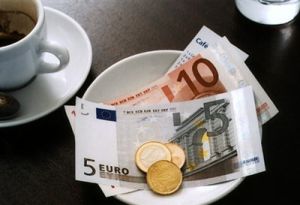 Tips, called service in France, is almost always included in the listed prices and are automatically added in to your total bill (l’addition). If you see “Service Compris” it means the listed prices include the tip, or “Service non-compris” means 15% will be added to your total before you are given the bill.
Tips, called service in France, is almost always included in the listed prices and are automatically added in to your total bill (l’addition). If you see “Service Compris” it means the listed prices include the tip, or “Service non-compris” means 15% will be added to your total before you are given the bill.
It is not necessary to leave an additional tip in France, although it is customary to leave a very small tip in addition to the service charge, especially if the service was good. However, tipping an additional 10%-20% is definitely not necessary when dining out in France. A euro or so per person or per couple is more than enough.
VEGETARIANS IN FRANCE
As a meat eater, I do not have much personal experience with being a vegetarian in France. I have traveled with a vegetarian and have talked to vegetarians who have all told me the same thing: it’s hard to avoid meat when in France.
While the French tend to eat a lot of veggies, making it easy to get enough food without any meat, you will probably also have some problems finding meat substitutes or dishes without some sort of meat component in them. Also be prepared from some slightly raised eyebrows if you inform someone that you’d rather pass on meat.
Here are some helpful phrases for vegetarians in France:
- Je suis vegeatarien: I am a vegetarian
- Je ne mange pas la viande: I do not eat meat
- Je ne mange pas du poisson: I do not eat fish (or if you are a vegetarian that does eat fish, “je mange du poisson”)
- Je ne mange pas du poulet: I do not eat poultry/chicken (if you simply say you don’t eat meat, they may think you do eat chicken)
TYPES OF RESTAURANTS IN FRANCE
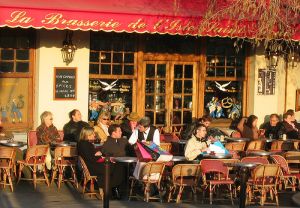 Restaurant: Where you can get a complete meal, and will often find price fixed menus. Prices will range widely depending on the type of restaurant and the reputation of the chef.
Restaurant: Where you can get a complete meal, and will often find price fixed menus. Prices will range widely depending on the type of restaurant and the reputation of the chef.
Brasserie: Originally a place where only beer was served, brasseries tend to have pub-style, hearty food—French style of course, which means anything from steak frites (steak and fries) to salads and croquet madams.
Bistro: Small, family run restos
Café: Basically an establishment that serves all kinds of drinks, from coffee to aperitifs. They will sometimes also offer sandwiches and desserts.
Bar: You’ll find coffee and pastries here in the mornings and boozy drinks the rest of the day. They will also sometimes offer some prepared foods and cigarettes.
About the Author
Julie Blakley is the resident francophile at BootsnAll and when she’s not dreaming of creamy cheeses and crunchy baguettes, she’s busy writing for both the Paris Travel Guide and the France Travel Guide.
photos: eating in france by jypsygen, breakfast by Ana Branca, French picnic by Boofalo Blue, Paris Menu by Plug 1, Duck Confit by Avlxyz, Kir Royale by Drunken Monkey, Hot paris waiter byArslan , Brasserie by Mabel Flores